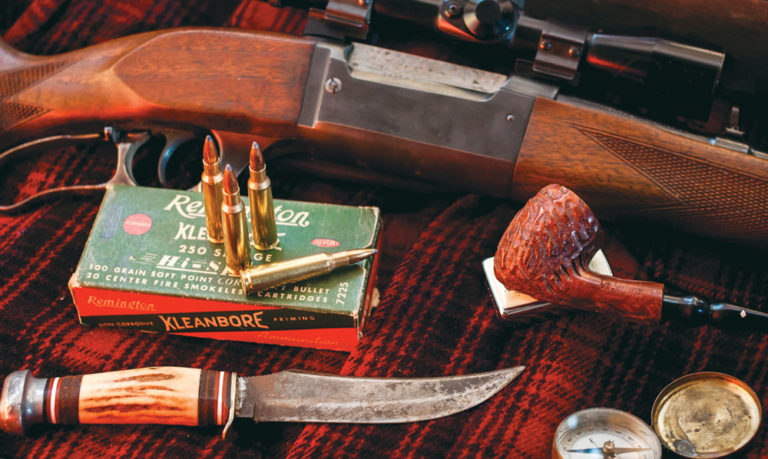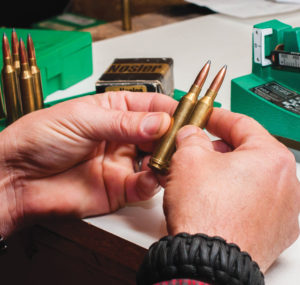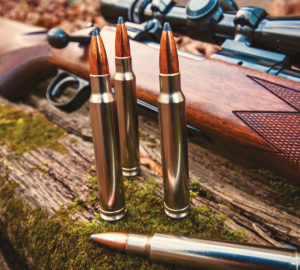

There are plenty of excellent cartridges that didn’t catch on. Their lack of overall popularity doesn’t mean discontinued cartridges need to be relegated to the ash heap of history.
“What am I going to do now? Do I try to buy up any and all ammunition, and only rarely use the rifle I like so much? Do I buy something more common?” Handloading is the solution. A competent handloader can revive discontinued cartridges from the brink of extinction. As long as the bullets and brass can still be purchased or made, the rifle will continue to have a long, healthy and happy life. The following are three examples of cartridges that can be easily returned to duty.
The 250/3000 Savage
Developed by renowned ballistician Charles Newton for the Savage Arms Co. in 1915, it was a speed demon for its day, achieving a then unheard of 3,000 fps with the 87-grain bullet. This benchmark influenced the very name of the cartridge, though it is also commonly known as the .250 Savage. It was a readily available chambering for the handy Savage 99 lever action, and was (and is) fully capable of pulling double duty on both varmints and deer-size game.
The handloader can easily bring these discontinued cartridges back around. Great .257-inch-diameter bullets, weighing from 87 grains to 120 grains, are available from almost all manufacturers, and Remington still produces component brass. Loaded with a medium burn rate powder such as IMR4064, Hodgdon’s Varget or Alliant Reloder 15, very good ammunition can be made to feed your .250 and provide a lifetime of hunting and shooting memories. It’s a lot of fun to head into the deer woods with an old Savage 99 just as our forefathers did.

The .264 Winchester Magnum
The late 1950s saw Winchester release a trio of belted magnum cartridges, all based on the .375 Holland & Holland case, but shortened to fit in a .30-06 length receiver. The .458 Winchester Magnum filled the African niche created by the demise of Kynoch ammunition, and the .338 Winchester Magnum was destined to be America’s elk medicine, but the .264 was immediately a bit of a threat. It was irreverent enough to tread upon the hallowed ground ruled by the .270 Winchester.
The long, lean 6.5mm bullets, when pushed through Winchester’s Westerner rifle that sported a 26-inch barrel, produced impressive velocities that could make hitting distant targets easier. The 100-grain bullets could be pushed in excess of 3,500 fps, and the 140-grain slugs hit the 3,200 fps mark.
The bullets bucked the wind very well, but these speeds gave the cartridge a reputation as a barrel burner. Not long after its introduction, Winchester made the decision to shorten the barrels of the .264 rifles, and a correlative velocity reduction was the result. Often, the .264 was at or less than the velocity of the venerable .270 Winchester. By 1962, Remington released the 7mm Remington Magnum and the .264 was doomed. The shooting public loved the 7mm Magnum and turned a blind eye to the .264 Winchester. Factory ammunition is still available, in limited quantities, but few production rifles were chambered for the big 6.5mm.
I like to see a 26-inch barrel on a .264 to maximize the powder capacity of this case, and I like to see it fueled by the slower burning powders available today, like Reloder 22 or 25, H4831SC and IMR4350 or IMR7828. Stick a magnum rifle primer in there and you should have a recipe for success. As far as the barrel burner moniker, if you don’t heat that barrel to the point where you can light your cigar off the muzzle, it should give you a lifetime of service.
Big Discontinued Cartridges: 8mm Remington Magnum

In 1979, Remington went out on a limb and revealed a metric designation as the new big game round in their lineup. We Americans have generally shied away from metric designations; perhaps we like the bastardized decimal portions of an inch measurement. The 8mm Magnum sounded strange, and though the name was perhaps a gamble on the popularity of the 7mm Remington Magnum, it was not very well received. Available in the Model 700 rifle, the 8mm Magnum was a powerhouse, pushing a 220-grain bullet to almost 3,000 fps. This is a big game rifle, but alas, the .338 Winchester had enough time to spread roots, and trying to upset that apple cart would not be easy.
However, those who used the 8mm Remington had great success, and its followers are fervent over this cartridge. I’ve spoken with some very big names in the shooting and hunting world that have come to love this metric oddball. Using a bullet of 180, 200 or 220 grains, this cartridge makes a great choice for elk, moose, bear or bison in North America and really shines on the African game fields. Top it with a premium bonded-core bullet and you’ll avoid premature bullet break up, and get the deep penetration and energy transfer we are all after. It is a bit on the heavy side for deer, but has put its fair share of venison in the freezer.
Like the previously mentioned .264, it comes into its own with slow burning powders and magnum primers. Barnes, Nosler, Swift, Hornady, Remington and Sierra make wonderful projectiles in 8mm, and cases are still produced by Remington and Nosler Custom. In our test rifle, a 220-grain Sierra Game King and a healthy dose of Reloder 25 in a Nosler Custom case gave very accurate results, with three-shot groups hanging around ¾ inch. For those who enjoy the full magnum length receiver, this cartridge, when paired with a .375 H&H or .416 Remington, would make a great set of rifles for the traveling adventurer. Give me an accurate 8mm with a 220-grain Sierra Game King or Swift AFrame, and I’d be comfortable hunting 90 percent of the world’s game.
Parting Shot
All three of these discontinued cartridges have a common denominator: rarity. Save your brass for reloading and find an accurate load that works well. With a decent stockpile of projectiles, you can keep that near-obsolete rifle in the field for a lifetime.
This article originally appeared in the August 28, 2014 issue of Gun Digest the Magazine.

Next Step: Get your FREE Printable Target Pack
Enhance your shooting precision with our 62 MOA Targets, perfect for rifles and handguns. Crafted in collaboration with Storm Tactical for accuracy and versatility.
Subscribe to the Gun Digest email newsletter and get your downloadable target pack sent straight to your inbox. Stay updated with the latest firearms info in the industry.

![Best Concealed Carry Guns In 2025 [Field Tested] Wilson Combat EDC X9S 1](https://gundigest.com/wp-content/uploads/Wilson-Combat-EDC-X9S-1-324x160.jpg)


![Best 9mm Carbine: Affordable PCCs [Tested] Ruger Carbine Shooting](https://gundigest.com/wp-content/uploads/Ruger-Carbine-Shooting-100x70.jpg)
![Best AR-15: Top Options Available Today [Field Tested] Harrington and Richardson PSA XM177E2 feature](https://gundigest.com/wp-content/uploads/Harrington-and-Richardson-PSA-XM177E2-feature-100x70.jpg)

Encouraged by the article being I bought a couple of 325wsm rifles after the cartridge was introduced. Now all I have to do is learn how to reload well. Likely more involved to get consistent ammo than one might imagine. What the heck, another hobby to take up.
I own and hunt with a Savage bolt action model 16 in 250-3000, so I hand load ammo for my own purposes. I used it successfully on Antelope at a range of 275 yards, also on whitetail out to 175 yards.
I now use the firearm as my Youth rifle centerfire for deer hunting when I take first time teenagers to the stand. We practice with the Savage Mk II 22 for several sessions at 50 yards so they gain confidence and can ethically take game at 50-125 yards. The 250 Savage is an ideal round for this activity.
I reload Hornady Flex tips in 30/30 to hunt with a Winchester model 94 (picture a model 64) a 1971 NRA Commemorative. I put Leupold QRW rings along with a Leupold 2.5 x Scout scope on the XS scout sight mount in place of the rear folding leaf, installed a Williams FP receiver and Firesight in front hood as a backup. What a terrific combo for youths that want to shoot the scout (either left or right handed) or prefers the aperture sight. The firearm has a 24 inch barrel yet weighs less than 6 lbs and the balance. LOP, is ideal for the youth hunters.
Backfire, If you need some 250 Savage ammo contact me at [email protected] , I have several boxes I have no use for
I have acquired a BSA model 1923 rifle in the long discontinued .26 HV cartridge. This range of HV cartridges was released by BSA after the 1st World War and although being way ahead of its time was not well received. The rifle I have is believed to be one of only 50 built. And building a suitable hand loaded round is possible but time consuming. Firstly the case can be fairly easily produced by FL resizing a 7×61 Sharp and Hart (Super ) which is a belted magnum. The projectile was another matter, Bore size being .269 it was found early in the piece that a 6.5mm (.264) projectile had insufficient size to contact the rifling and stabilise, shot woefully!! I have recently acquire some CH4D bullet sizing dies to resize a .277 project in 2 passes to .269 .All I can say at this stage is the dies work a treat and can now easily make .269 projectiles . I’m now going back to the load development stages to see if I can get an accurate round, I think all things are now in my favour so success should be imminent. So as you can see I am working hard to keep this particular discontinued round fully operational…. will post more after the test firing
Cheers for now
One of my favorite rifles is a Winchester Model 70 Lightweight Carbine in .250-3000. I load it primarily with 87-100 grain bullets, and it has performed superbly since the day I purchased it over 20 years ago, but the scarcity of brass and factory ammunition has become a problem for me. I am reluctant to sell or trade for another, but I may have it rebarreled to .243 Win or .257 Roberts. For a cartridge that has performed so well, I am surprised and disappointed that the market hasn’t recognized its merits.
One of the shooting worlds great losses was the discontinuation of the 222 Remington Magnum. It was a much better cartridge than the .223 Remington but surplus military brass simply killed off the 222 Rem. Mag. The Mag had more powder capacity and a longer neck which made it the more accurate cartridge with high velocity to boot and it still had the long barrel life of the .223.